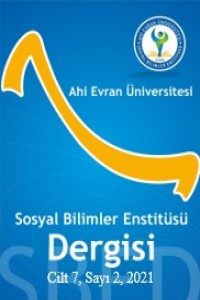Öz
Günümüzde internet ve diğer bilişim teknolojilerinin kullanımı hızla artmaktadır. Buna bağlı olarak eğitim öğretim kurumları da bu teknolojilere uyum sağlamaya ve eğitim öğretim kalitesini artıracak yazılımları kullanmaya başlamışlardır. Bu bağlamda özellikle yükseköğretim kurumları kontrol mekanizması sağlayacak ve öz değerlendirme yapma imkânı sağlayan öğretim yönetim sistemlerini kullanmaya başlamışlardır. Bu çalışmada Kırşehir Ahi Evran Üniversitesi tarafından eğitimde kaliteyi artırmayı ve yeterliğe dayalı bir öğrenme yaklaşımı ile eğitimde kalite güvence sistemi oluşturmak amacıyla geliştirdiği AYDEP sisteminin sistem kabul edilebilirlik modeline göre değerlendirilmesi amaçlanmıştır. Araştırmanın çalışma grubunu sistemi aktif olarak kullanan 123 öğrenci ve 27 öğretim elemanı oluşturmaktadır. Araştırmada araştırmacılar tarafından geliştirilen AYDEP sistem değerlendirme anketi kullanılmıştır. Araştırma sonucuna göre AYDEP sistemi kullanıcılar tarafından teknik kabul edilebilirlik boyutuna ilişkin (teknik özellikler, tasarımın kullanıcı seviyesine uygunluğu, menülerin hatasız çalışması ve yapılan işlemlerin verimli olması) açılarından ortalamanın üzerinde, sosyal kabul edilebilirlik boyutuna ilişkin tüm maddelerde ise ortalama seviyesinde puanlama yaptığı görülmüştür.
Anahtar Kelimeler
AYDEP Öğrenme yönetim sistemleri sistem kabuledilebilirlik modeli
Kaynakça
- Akça, Y. ve Özer, G. (2012). Teknoloji kabul modeli’nin kurumsal kaynak planlaması uygulamalarında kullanılması, Business and Economics Research Journal, 3: 79-96.
- Avcı Yücel, Ü ve Gülbahar, Y. (2013). Teknoloji kabul modeli: önceki yordayıcıların incelenmesi, Ankara Üniversitesi Eğitim Bilimleri Fakültesi Dergisi, 46(1): 89-109
- Beaudry, A., & Pinsonneault, A. (2010). The other side of acceptance: studying the direct and indirect effects of emotions on information technology use. MIS quarterly, 689-710.
- Bandura, A. (1982). Self-efficacy mechanism in human agency. American psychologist, 37(2), 122. Chang, Y., Dong, X., & Sun, W. (2014). Influence of characteristics of the Internet of Things on consumer purchase intention. Social Behavior and Personality: an international journal, 42(2), 321-330.
- Çavdar, L. (2018). Kodlama Öğretiminde Kullanılan Çevrimiçi Platformların Değerlendirilmesi: Code.Org Örneği. Tokat Gaziosmanpaşa Üniversitesi, Tokat.
- Coaldrake, P., & Stedman, L. (1999). Academic work in the twenty-first century. Canberra, Higher Education Division, Training and Youth Affairs.
- Davis, F. D. (1985). A technology acceptance model for empirically testing new end-user information systems: Theory and results. Massachusetts Institute of Technology. Demirkol, D., & Şeneler, Ç. (2018). A Turkish Translation of the System Usability Scale: The SUS-TR. Uşak Üniversitesi Sosyal Bilimler Dergisi, 11(3), 237-253.
- Dutton, W. H., Cheong, P. H., & Park, N. (2004). The Social Shaping of a Virtual Learning Environment: The Case of a University-Wide Course Management System. Electronic Journal of e-learning, 2(1), 69-80.
- Karasar, N. (2012). Bilimsel Araştırma Yöntemleri. Ankara: Nobel Yayıncılık. Kim, J., & Lennon, S. J. (2013). Effects of reputation and website quality on online consumers' emotion, perceived risk and purchase intention. Journal of Research in Interactive Marketing.
- Leech, N. L., Barrett, K.C. and Morgan, G.A. (2005). SPSS for Intermediate Statistics: Use and Interpretation. (Second Edition). NJ: Lawrence Erlbaum Associates, Inc.
- Levin, J., Fox, J. A. ve Forde, D. R. (2010). Elementary statistics in social research. Boston: Allyn & Bacon Pearson.
- Lonn, S., & Teasley, S. D. (2009). Saving time or innovating practice: Investigating perceptions and uses of Learning Management Systems. Computers & Education, 53(3), 686-694.
- Malhotra, Y., & Galletta, D. F. (1999). Extending the technology acceptance model to account for social influence: Theoretical bases and empirical validation. Paper presented at the Proceedings of the 32nd Annual Hawaii International Conference on Systems Sciences. 1999. HICSS-32. Abstracts and CD-ROM of Full Papers.
- Nielsen, J. (1990). Evaluating hypertext usability (pp. 147-168). Berlin: Springer-Verlag.
- Nielsen, J. (1994). Usability engineering: Elsevier.
- Paulsen, M. F., Nipper, S., & Holmberg, C. (2003). Online education: Learning management systems: Global e-learning in a scandinavian perspective.
- Scherer, R. F. (1988). Dimensionality of Coping: Factor Stability Using the Ways of Coping Questionnaire, Psychological Report, Cilt: 62, s.76-770.
- Şencan, H. (2005). Sosyal ve davranıssal ölçümlerde güvenirlik ve geçerlik. (1.b). Ankara: Seçkin yayınları.
- Tabachnick and Fidell (2013). B.G. Tabachnick, L.S. Fidell Using Multivariate Statistics (sixth ed.) Pearson, Boston.
- Tavşancıl, E. (2005). Tutumların ölçülmesi ve SPSS ile veri analizi. (2.b). Ankara: Nobel yayınları. No 339.
- Ursavaş, Ö.F., Şahin, S. ve McIlory, D. (2014). Technology acceptance measure for teachers: t-tam (öğretmenler için teknoloji kabul ölçeği: ö-tkö), Eğitimde Kuram ve Uygulama, 10(4): 885-917. Volery, T., & Lord, D. (2000). Critical success factors in online education. International journal of educational management, 14(5), 216-223.
- Yücel, Ü. A., & Gülbahar, Y. (2013). Teknoloji Kabul Modeli: Önceki Yordayıcıların İncelenmesi. Ankara Üniversitesi Eğitim Bilimleri Fakültesi Dergisi, 46(1), 89-109.
- West, R. E., Waddoups, G., & Graham, C. R. (2007). Understanding the experiences of instructors as they adopt a course management system. Educational Technology Research and Development, 55(1), 1-26.
Ayrıntılar
| Birincil Dil | Türkçe |
|---|---|
| Bölüm | Makaleler |
| Yazarlar | |
| Yayımlanma Tarihi | 31 Temmuz 2021 |
| Gönderilme Tarihi | 18 Aralık 2020 |
| Yayımlandığı Sayı | Yıl 2021 Cilt: 7 Sayı: 2 |


